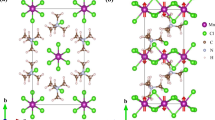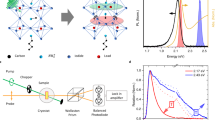Abstract
Spintronic devices, by harnessing the spin degree of freedom, are expected to outperform charge-based devices in terms of energy efficiency and speed of operation. The use of an electric field to control spin at room temperature has been pursued for decades. A major hurdle that has contributed to the slow progress in this regard is the dilemma between effective control and strong spin relaxation. For example, in a Rashba/Dresselhaus material with strong spin–orbit coupling, although the internal magnetic field could be substantial enough to effectively control spin precession, often, the spin-relaxation time becomes extremely short as a consequence of Dyakonov–Perel scattering. To address this, a persistent spin helix has been proposed in systems with SU(2) symmetry. Here we show the discovery of the persistent spin helix in an organic–inorganic hybrid ferroelectric halide perovskite whose layered nature makes it intrinsically like a quantum well. We demonstrate that the spin-polarized band structure is switchable at room temperature via an intrinsic ferroelectric field. We reveal valley–spin coupling through a circular photogalvanic effect in single-crystalline bulk crystals. The favoured short spin helix wavelength (three orders of magnitude shorter than in III–V materials), room-temperature operation and non-volatility make the hybrid perovskite an ideal platform for understanding symmetry-tuned spin dynamics, towards designing practical spintronic materials and devices that can resolve the control-relaxation dilemma.
This is a preview of subscription content, access via your institution
Access options





Similar content being viewed by others
Data availability
The data supporting the findings of this study are available within the paper.
Code availability
Codes are available upon reasonable request from the corresponding authors.
References
Ohno, H. et al. Electric-field control of ferromagnetism. Nature 408, 944–946 (2000).
Wunderlich, J. et al. Spin Hall effect transistor. Science 330, 1801–1804 (2010).
Wang, K. L. et al. Electric-field control of spin-orbit interaction for low-power spintronics. Proc. IEEE 104, 1974–2008 (2016).
Jiang, M., Asahara, H., Sato, S., Ohya, S. & Tanaka, M. Suppression of the field-like torque for efficient magnetization switching in a spin–orbit ferromagnet. Nat. Electron. 3, 751–756 (2020).
Huai, Y. Spin-transfer torque MRAM (STT-MRAM): challenges and prospects. AAPPS Bulletin 18, 33–40 (2008).
Kawahara, T., Ito, K., Takemura, R. & Ohno, H. Spin-transfer torque RAM technology: review and prospect. Microelectron. Reliab. 52, 613–627 (2012).
Dietl, T. A ten-year perspective on dilute magnetic semiconductors and oxides. Nat. Mater. 9, 965–974 (2010).
Dietl, T. & Ohno, H. Dilute ferromagnetic semiconductors: physics and spintronic structures. Rev. Mod. Phys. 86, 187 (2014).
Jungfleisch, M. B., Zhang, W. & Hoffmann, A. Perspectives of antiferromagnetic spintronics. Phys. Lett. A 382, 865–871 (2018).
Maruyama, T. et al. Large voltage-induced magnetic anisotropy change in a few atomic layers of iron. Nat. Nanotechnol. 4, 158–161 (2009).
Shiota, Y. et al. Induction of coherent magnetization switching in a few atomic layers of FeCo using voltage pulses. Nat. Mater. 11, 39–43 (2012).
Datta, S. & Das, B. Electronic analog of the electro‐optic modulator. Appl. Phys. Lett. 56, 665–667 (1990).
Winkler, R., Papadakis, S., De Poortere, E. & Shayegan, M. Spin-Orbit Coupling in Two-Dimensional Electron and Hole Systems (Springer, 2003).
Žutić, I., Fabian, J. & Sarma, S. D. Spintronics: fundamentals and applications. Rev. Mod. Phys. 76, 323 (2004).
Bychkov, Y. & Rashba, E. Properties of a 2D electron gas with lifted spectral degeneracy. J. Exp. Theor. Phys. Lett. 39, 78–81 (1984).
Manchon, A., Koo, H. C., Nitta, J., Frolov, S. & Duine, R. New perspectives for Rashba spin–orbit coupling. Nat. Mater. 14, 871–882 (2015).
Stranks, S. D. & Plochocka, P. The influence of the Rashba effect. Nat. Mater. 17, 381–382 (2018).
Lee, H., Im, J. & Jin, H. Emergence of the giant out-of-plane Rashba effect and tunable nanoscale persistent spin helix in ferroelectric SnTe thin films. Appl. Phys. Lett. 116, 022411 (2020).
Autieri, C., Barone, P., Sławińska, J. & Picozzi, S. Persistent spin helix in Rashba–Dresselhaus ferroelectric CsBiNb2O7. Phys. Rev. Mater. 3, 084416 (2019).
Koralek, J. D. et al. Emergence of the persistent spin helix in semiconductor quantum wells. Nature 458, 610–613 (2009).
Walser, M., Reichl, C., Wegscheider, W. & Salis, G. Direct mapping of the formation of a persistent spin helix. Nat. Phys. 8, 757–762 (2012).
Ohno, M. & Yoh, K. Vanishing of inhomogeneous spin relaxation in InAs-based field-effect transistor structures. Phys. Rev. B 75, 241308 (2007).
Nitta, J., Akazaki, T., Takayanagi, H. & Enoki, T. Gate control of spin-orbit interaction in an inverted In0.53Ga0.47As/In0.52Al0.48As heterostructure. Phys. Rev. Lett. 78, 1335–1338 (1997).
Zhang, H.-Y. et al. Observation of vortex domains in a two-dimensional lead iodide perovskite ferroelectric. J. Am. Chem. Soc. 142, 4925–4931 (2020).
Zhai, Y. et al. Giant Rashba splitting in 2D organic-inorganic halide perovskites measured by transient spectroscopies. Sci. Adv. 3, e1700704 (2017).
Hong, X., Ishihara, T. & Nurmikko, A. Dielectric confinement effect on excitons in PbI4-based layered semiconductors. Phys. Rev. B 45, 6961–6964 (1992).
Wang, S., Huang, M., Wu, Y. N. & Chen, S. Absolute volume deformation potentials of inorganic ABX3 halide perovskites: the chemical trends. Adv. Theory Simulations 4, 2100060 (2021).
Frost, J. M. et al. Atomistic origins of high-performance in hybrid halide perovskite solar cells. Nano Lett. 14, 2584–2590 (2014).
Dar, M. I. et al. Origin of unusual bandgap shift and dual emission in organic-inorganic lead halide perovskites. Sci. Adv. 2, e1601156 (2016).
Wright, A. D. et al. Electron–phonon coupling in hybrid lead halide perovskites. Nat. Commun. 7, 11755 (2016).
Chen, Z. et al. Remote phononic effects in epitaxial Ruddlesden–Popper halide perovskites. J. Phys. Chem. Lett. 9, 6676–6682 (2018).
Guo, Z., Wu, X., Zhu, T., Zhu, X. & Huang, L. Electron-phonon scattering in atomically thin 2D perovskites. ACS Nano 10, 9992–9998 (2016).
Chen, T. et al. Origin of long lifetime of band-edge charge carriers in organic-inorganic lead iodide perovskites. Proc. Natl Acad. Sci. USA 114, 7519–7524 (2017).
Booker, E. P. et al. Formation of long-lived color centers for broadband visible light emission in low-dimensional layered perovskites. J. Am. Chem. Soc. 139, 18632–18639 (2017).
Fu, Y. et al. Multicolor heterostructures of two-dimensional layered halide perovskites that show interlayer energy transfer. J. Am. Chem. Soc. 140, 15675–15683 (2018).
Harris, D. C. & Bertolucci, M. D. Symmetry and Spectroscopy: an Introduction to Vibrational and Electronic Spectroscopy (Courier Corporation, 1989).
Ganichev, S. D. & Prettl, W. Spin photocurrents in quantum wells. J. Phys. Condens. Matter 15, R935 (2003).
Osterhoudt, G. B. et al. Colossal mid-infrared bulk photovoltaic effect in a type-I Weyl semimetal. Nat. Mater. 18, 471–475 (2019).
Gibson, A. & Kimmitt, M. Photon drag detection. Infrared Millimeter Waves 3, 181–217 (1980).
Sturman, B. I. & Fridkin, V. M. Photovoltaic and Photo-Refractive Effects in Noncentrosymmetric Materials (Routledge, 2021).
Belinicher, V., Ivchenko, E. & Sturman, B. Kinetic theory of the displacement photovoltaic effect in piezoelectrics. Zh. Eksp. Teor. Fiz. 83, 649–661 (1982).
Quereda, J. et al. Symmetry regimes for circular photocurrents in monolayer MoSe2. Nat. Commun. 9, 3346 (2018).
Ji, Z. et al. Spatially dispersive circular photogalvanic effect in a Weyl semimetal. Nat. Mater. 18, 955–962 (2019).
Jin, L., Li, F. & Zhang, S. in Progress in Advanced Dielectrics (ed Jin, L.) Ch. 2, 21–104 (World Scientific, 2020).
Hong, C. et al. Enhanced piezoelectric and dielectric properties of Pb (Yb1/2Nb1/2)O3-Pb (Mg1/3Nb2/3)O3-PbTiO3 crystals by combining alternating and direct current poling. J. Appl. Phys. 129, 124101 (2021).
Sundararaman, R. et al. JDFTx: software for joint density-functional theory. SoftwareX 6, 278–284 (2017).
Perdew, J. P., Burke, K. & Ernzerhof, M. Generalized gradient approximation made simple. Phys. Rev. Lett. 77, 3865–3868 (1996).
Grimme, S. Semiempirical GGA‐type density functional constructed with a long‐range dispersion correction. J. Comput. Chem. 27, 1787–1799 (2006).
Hamann, D. Optimized norm-conserving Vanderbilt pseudopotentials. Phys. Rev. B 88, 085117 (2013).
Marzari, N. & Vanderbilt, D. Maximally localized generalized Wannier functions for composite energy bands. Phys. Rev. B 56, 12847–12865 (1997).
Acknowledgements
This work is supported by the US ARO under grant no. W911NF-21-1-0013 (J.S. and R.S.), the US AFOSR under award no. FA9550-18-1-0116 (J.S.), the US AFOSR under award no. FA9550-YR-1-XYZQ (Y.P.), the New York State’s Empire State Development’s Division of Science, Technology and Innovation through Focus Center contract no. C180117 (L.Z., J.S., Z.L. and T.M.L.) and the US National Science Foundation under award nos. 1706815 (J.S.), 2031692 (J.S.) and 1916652 (R.S. and J.S.).
Author information
Authors and Affiliations
Contributions
J.S., R.S., Y.P. and L.Z. conceived and developed the idea. L.Z., Y.H., J.J. and J.S. planned the experiments. L.Z. and J.J. prepared samples and devices. L.Z. and J.J. performed optical and PL experiments. L.Z. performed ferroelectric polarization tests and SEM studies. L.Z. and J.J. performed CPGE measurements. C. Multunas, M.C., R.S., Y.P., C. Ming and Y.-Y.S. performed DFT calculations. Y.H. performed XRD and Z.L. performed EBSD. L.Z. processed the raw data. L.Z., C. Multunas, Y.P., R.S. and J.S. analysed and interpreted the results. L.Z. prepared the initial manuscript draft and J.S. revised it. All authors were involved in the discussion of data analysis and the writing of the manuscript. J.S., R.S. and Y.P. supervised the project.
Corresponding authors
Ethics declarations
Competing interests
The authors declare no competing interests.
Peer review
Peer review information
Nature Photonics thanks Jean Luc Pelouard and the other, anonymous, reviewer(s) for their contribution to the peer review of this work.
Additional information
Publisher’s note Springer Nature remains neutral with regard to jurisdictional claims in published maps and institutional affiliations.
Supplementary information
Supplementary Information
Supplementary Figs. 1–21, Discussions 1–3 and Tables 1–3.
Rights and permissions
About this article
Cite this article
Zhang, L., Jiang, J., Multunas, C. et al. Room-temperature electrically switchable spin–valley coupling in a van der Waals ferroelectric halide perovskite with persistent spin helix. Nat. Photon. 16, 529–537 (2022). https://doi.org/10.1038/s41566-022-01016-9
Received:
Accepted:
Published:
Issue Date:
DOI: https://doi.org/10.1038/s41566-022-01016-9
This article is cited by
-
Defect-induced helicity dependent terahertz emission in Dirac semimetal PtTe2 thin films
Nature Communications (2024)
-
Resolving electron and hole transport properties in semiconductor materials by constant light-induced magneto transport
Nature Communications (2024)
-
How spin relaxes and dephases in bulk halide perovskites
Nature Communications (2024)
-
Substrate effects on spin relaxation in two-dimensional Dirac materials with strong spin-orbit coupling
npj Computational Materials (2023)
-
Alloy-induced reduction and anisotropy change of lattice thermal conductivity in Ruddlesden–Popper phase halide perovskites
Frontiers of Physics (2023)



